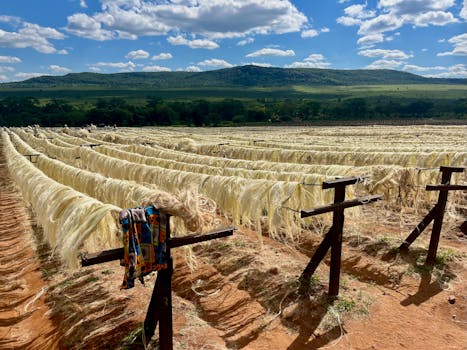Natural Fibers, Global Markets: Africa’s Role in the Sustainable Textile Revolution

Natural Fibers, Global Markets: Africa’s Role in the Sustainable Textile Revolution
Natural Fibers, Global Markets: Africa’s Role in the Sustainable Textile Revolution. The world is shifting towards sustainable and eco-friendly practices, and the textile industry is no exception. Natural fibers, such as cotton, hemp, and flax, are gaining popularity due to their biodegradable and renewable properties. Africa, with its vast agricultural land and favorable climate, is poised to play a significant role in the sustainable textile revolution.
Introduction to Natural Fibers
Natural fibers are derived from plants, animals, or mineral sources. They are biodegradable, non-toxic, and require less energy to produce compared to synthetic fibers. The most common natural fibers used in the textile industry are cotton, jute, hemp, flax, and silk. These fibers have been used for centuries, and their popularity is increasing due to the growing demand for sustainable and eco-friendly products.
Africa’s Potential in the Natural Fiber Market
Africa has the potential to become a major player in the global natural fiber market. The continent has vast agricultural land, favorable climate, and an abundance of natural resources. Many African countries, such as Egypt, South Africa, and Morocco, are already major producers of natural fibers. However, the industry faces challenges such as lack of infrastructure, limited access to markets, and competition from synthetic fibers.
Opportunities and Challenges Facing the Industry
The natural fiber industry in Africa faces several opportunities and challenges. One of the major opportunities is the growing demand for sustainable and eco-friendly products. Many international brands are looking for suppliers of natural fibers, and African countries can capitalize on this trend. However, the industry also faces challenges such as lack of investment, limited access to technology, and competition from established players.
Conclusion
In conclusion, Africa has the potential to play a significant role in the sustainable textile revolution. The continent’s vast agricultural land, favorable climate, and abundance of natural resources make it an ideal location for the production of natural fibers. However, the industry faces challenges such as lack of infrastructure, limited access to markets, and competition from synthetic fibers. With the right investment, technology, and policies, Africa can become a major player in the global natural fiber market.




